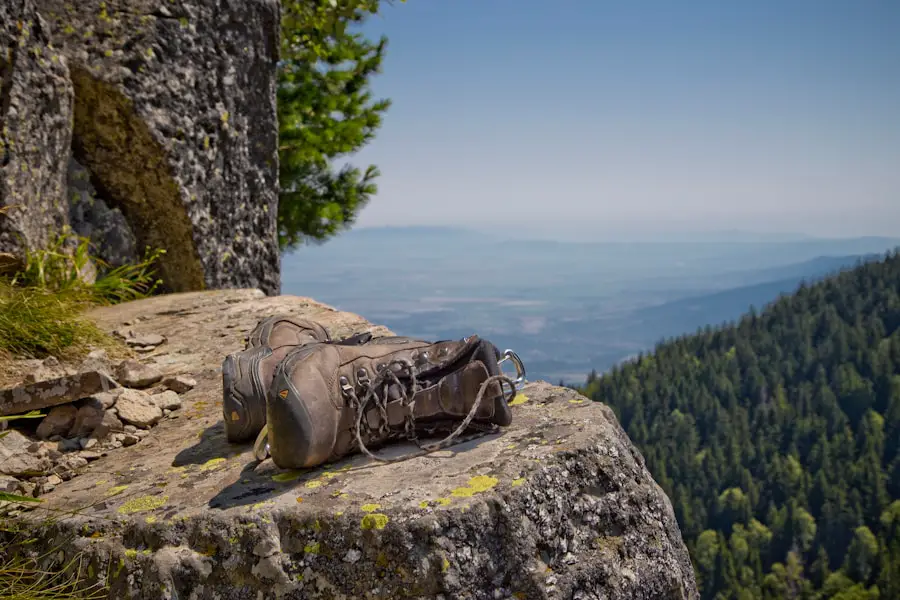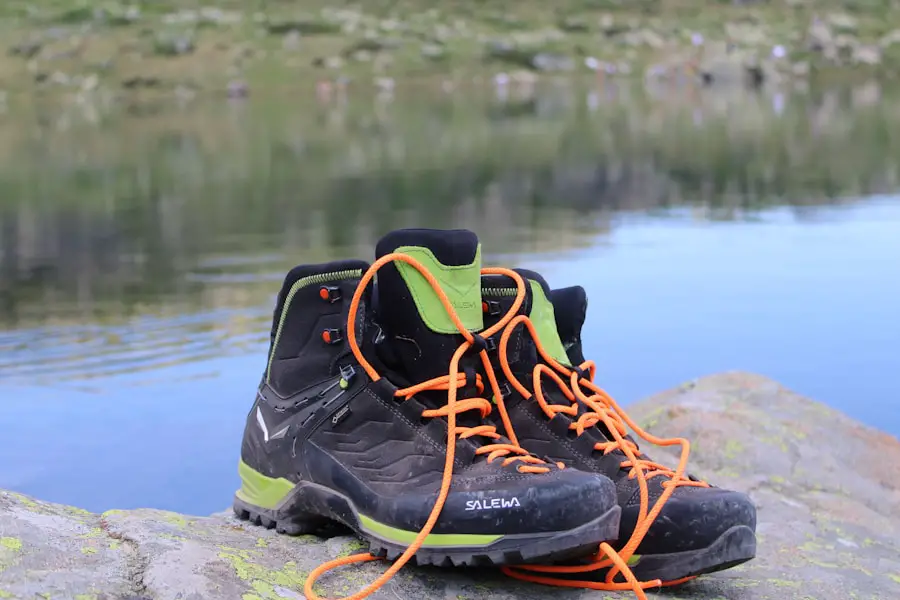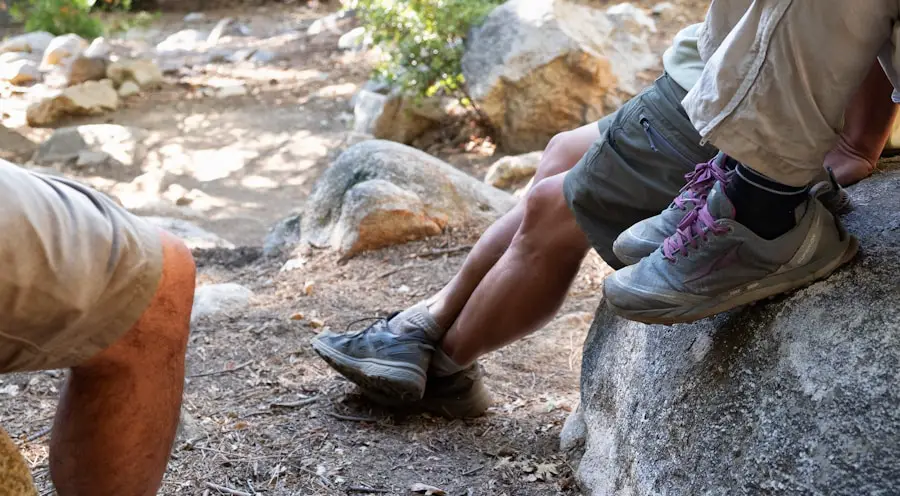Breaking in hiking boots is a crucial step for any outdoor enthusiast. Properly broken-in boots can significantly enhance comfort and performance on the trail, reducing the risk of blisters and other foot ailments. When you first purchase a pair of hiking boots, they often come stiff and unyielding, designed to provide support and protection.
However, this rigidity can lead to discomfort if the boots are worn for extended periods without prior acclimatization. The process of breaking in allows the materials to soften and conform to the unique shape of your feet, creating a personalized fit that can make all the difference during long hikes. Moreover, breaking in your hiking boots is not just about comfort; it also plays a vital role in ensuring safety.
Ill-fitting boots can lead to missteps, slips, or even falls, especially on uneven terrain. A well-fitted boot provides better traction and stability, which is essential when navigating rocky paths or steep inclines. By taking the time to break in your boots properly, you are investing in your overall hiking experience, allowing you to focus on the beauty of nature rather than the discomfort of your footwear.
Key Takeaways
- Breaking in hiking boots is important to prevent blisters and discomfort on the trail
- Factors to consider include the material of the boots, your foot shape, and the type of hiking you’ll be doing
- It can take anywhere from a few days to a few weeks to properly break in hiking boots
- Tips for breaking in hiking boots include wearing them around the house, using thick socks, and gradually increasing wear time
- Signs that your hiking boots are properly broken in include no more discomfort or blisters while hiking
Factors to Consider When Breaking in Hiking Boots
Several factors influence how you should approach breaking in your hiking boots. First and foremost is the type of material used in the construction of the boots. Leather boots, for instance, tend to require a longer break-in period compared to synthetic materials.
Leather is durable and offers excellent support but can be stiff initially. On the other hand, synthetic boots may feel more comfortable right out of the box but might not provide the same level of durability over time. Understanding the material will help you set realistic expectations for the break-in process.
Another critical factor is the design and fit of the boot itself. Different brands and models cater to various foot shapes and sizes. Some hikers may have wider feet, while others may have high arches or flat feet.
It’s essential to choose a boot that accommodates your specific foot structure. Additionally, consider the type of socks you plan to wear while hiking. Thick wool socks may require a different break-in approach than thin synthetic ones.
The combination of boot design, material, and sock choice will dictate how you should proceed with breaking in your new hiking footwear.
How Long Does it Take to Break in Hiking Boots?

The duration required to break in hiking boots can vary widely based on several factors, including the boot’s material, design, and how often you wear them during the break-in period. Generally speaking, leather boots may take anywhere from 20 to 40 hours of wear before they feel comfortable enough for long hikes. This process can be expedited by wearing them around the house or during short walks before hitting the trails.
In contrast, synthetic boots might only need about 10 to 20 hours of wear to achieve a comfortable fit. It’s important to note that breaking in your boots is not a one-size-fits-all process. Some individuals may find their boots conform to their feet more quickly than others due to differences in foot shape or sensitivity.
Additionally, the terrain on which you wear your boots during this period can also affect how quickly they break in. Walking on varied surfaces—such as grass, pavement, or gravel—can help accelerate the softening of materials while allowing you to assess how well the boots perform under different conditions.
Tips for Breaking in Hiking Boots
| Tip | Description |
|---|---|
| Choose the right size | Ensure your hiking boots fit properly to prevent blisters and discomfort. |
| Break them in gradually | Wear your boots for short walks before going on long hikes to allow them to mold to your feet. |
| Use thick socks | Wearing thick socks can help cushion your feet and prevent rubbing. |
| Apply waterproofing treatment | Protect your boots from moisture and prolong their lifespan by applying a waterproofing treatment. |
| Keep them clean | Regularly clean your boots to prevent dirt and debris from damaging the materials. |
To effectively break in your hiking boots, start by wearing them for short periods around your home or during casual outings. This initial phase allows your feet to adjust to the new footwear without subjecting them to the rigors of a long hike. Gradually increase the duration and intensity of wear as your comfort level improves.
For instance, after a few days of wearing them indoors, take them for a short walk on flat terrain before progressing to more challenging trails. Another useful tip is to incorporate different types of socks into your break-in routine. Experimenting with various thicknesses can help you determine which combination provides the best fit and comfort level.
Additionally, consider using boot stretchers or applying leather conditioner if you have leather boots that feel particularly stiff. These methods can help soften the material and expedite the break-in process. Always remember to listen to your body; if you experience significant discomfort or pain while breaking in your boots, it may be necessary to reassess their fit or consider alternative options.
Signs that Your Hiking Boots are Properly Broken In
Recognizing when your hiking boots are properly broken in is essential for ensuring a comfortable hiking experience. One clear sign is that you no longer feel any tightness or pinching around your toes or heels when wearing them. The materials should have softened enough to allow for natural movement without causing friction against your skin.
Additionally, you should be able to walk without experiencing any hotspots or areas of discomfort that could lead to blisters. Another indicator that your boots are ready for serious hiking is their ability to provide adequate support without feeling overly rigid. You should notice that they flex naturally with your foot’s movements while still offering stability on uneven terrain.
If you find yourself able to walk longer distances without fatigue or pain, it’s a strong indication that your boots have reached an optimal level of comfort and performance.
Common Mistakes to Avoid When Breaking in Hiking Boots

One common mistake many hikers make is rushing the break-in process. Eager to hit the trails with their new gear, some individuals may wear their boots for an entire day on a challenging hike right out of the box. This approach can lead to severe discomfort and even injury, as unbroken-in boots can cause blisters and other foot problems.
It’s crucial to allow adequate time for gradual acclimatization before embarking on longer treks. Another frequent error is neglecting to consider sock choice during the break-in period. Wearing inappropriate socks—whether too thick or too thin—can alter how well the boot fits and feels on your foot.
Additionally, failing to pay attention to lacing techniques can also lead to discomfort; improper lacing can create pressure points or restrict circulation, exacerbating any issues with fit. Taking time to adjust laces properly can make a significant difference in how your boots feel during both the break-in phase and subsequent hikes.
When to Replace Hiking Boots
Knowing when to replace your hiking boots is just as important as understanding how to break them in properly. Over time, even the best-quality boots will show signs of wear that can compromise their performance and safety features. One clear indicator that it’s time for a replacement is visible damage such as cracks in the sole or upper material, which can lead to reduced waterproofing and support.
Another sign that your hiking boots may need replacing is a noticeable decrease in comfort during hikes. If you find yourself developing blisters or experiencing foot pain that was previously absent, it could indicate that the cushioning or support has worn down significantly. Additionally, if you notice that your traction has diminished—such as slipping on wet surfaces or losing grip on rocky terrain—it’s time to consider investing in a new pair of boots designed for optimal performance.
Final Thoughts on Breaking in Hiking Boots
Breaking in hiking boots is an essential process that should not be overlooked by anyone who enjoys spending time on trails. By understanding the importance of this step and considering factors such as material and fit, hikers can ensure they select the right footwear for their adventures. The time invested in breaking in boots pays off significantly when it comes to comfort and safety on long hikes.
Moreover, being aware of common mistakes and knowing when it’s time for a replacement can further enhance your hiking experience. With proper care and attention during both the break-in phase and throughout their lifespan, hiking boots can provide reliable support and protection for many miles on various terrains. Ultimately, taking these steps will allow you to fully enjoy the beauty of nature without being hindered by discomfort or foot issues caused by ill-fitting footwear.
If you’re planning a multi-day trek and need to break in your hiking boots, you may also want to consider investing in a rechargeable hand warmer for travel. This handy device will keep your hands warm and comfortable during long hikes, ensuring that you can fully enjoy your outdoor adventure. Check out this article on the best hiking backpack for multi-day treks for more tips on how to prepare for your next getaway. Source
Love travel? Join Our Facebook Community For More Tips.
FAQs
What is the break-in period for hiking boots?
The break-in period for hiking boots can vary depending on the brand and style of the boot, but it typically takes around 20-30 miles of hiking to fully break them in.
How long does it take to break in leather hiking boots?
Leather hiking boots generally take longer to break in compared to synthetic materials. It can take around 30-40 miles of hiking to fully break in leather hiking boots.
What are some tips for breaking in hiking boots?
Some tips for breaking in hiking boots include wearing them around the house before hitting the trails, gradually increasing the distance of your hikes, and using specialized boot stretching products if needed.
Can I speed up the break-in process for hiking boots?
While it’s important to allow your feet and boots time to adjust, you can speed up the break-in process by wearing thick hiking socks, using a boot conditioner to soften the leather, and flexing the boots to help loosen them up.
How do I know if my hiking boots are properly broken in?
Properly broken-in hiking boots should feel comfortable and supportive, with minimal to no rubbing or hot spots. Your feet should feel secure and stable in the boots, and you should be able to hike long distances without discomfort.
